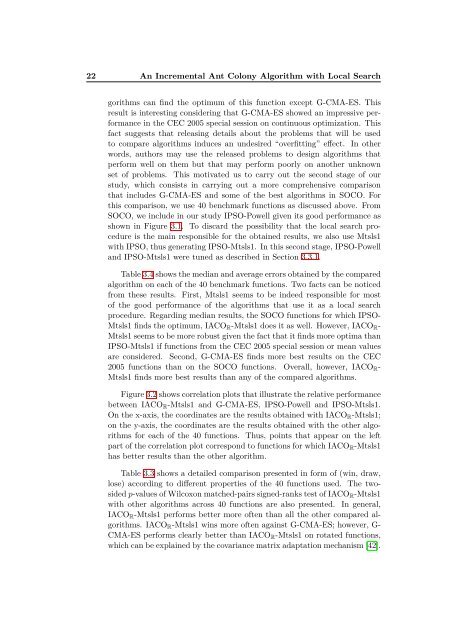Improved ant colony optimization algorithms for continuous ... - CoDE
Improved ant colony optimization algorithms for continuous ... - CoDE
Improved ant colony optimization algorithms for continuous ... - CoDE
Create successful ePaper yourself
Turn your PDF publications into a flip-book with our unique Google optimized e-Paper software.
22 An Incremental Ant Colony Algorithm with Local Search<br />
gorithms can find the optimum of this function except G-CMA-ES. This<br />
result is interesting considering that G-CMA-ES showed an impressive per<strong>for</strong>mance<br />
in the CEC 2005 special session on <strong>continuous</strong> <strong>optimization</strong>. This<br />
fact suggests that releasing details about the problems that will be used<br />
to compare <strong>algorithms</strong> induces an undesired “overfitting” effect. In other<br />
words, authors may use the released problems to design <strong>algorithms</strong> that<br />
per<strong>for</strong>m well on them but that may per<strong>for</strong>m poorly on another unknown<br />
set of problems. This motivated us to carry out the second stage of our<br />
study, which consists in carrying out a more comprehensive comparison<br />
that includes G-CMA-ES and some of the best <strong>algorithms</strong> in SOCO. For<br />
this comparison, we use 40 benchmark functions as discussed above. From<br />
SOCO, we include in our study IPSO-Powell given its good per<strong>for</strong>mance as<br />
shown in Figure 3.1. To discard the possibility that the local search procedure<br />
is the main responsible <strong>for</strong> the obtained results, we also use Mtsls1<br />
with IPSO, thus generating IPSO-Mtsls1. In this second stage, IPSO-Powell<br />
and IPSO-Mtsls1 were tuned as described in Section 3.3.1.<br />
Table 3.4 shows the median and average errors obtained by the compared<br />
algorithm on each of the 40 benchmark functions. Two facts can be noticed<br />
from these results. First, Mtsls1 seems to be indeed responsible <strong>for</strong> most<br />
of the good per<strong>for</strong>mance of the <strong>algorithms</strong> that use it as a local search<br />
procedure. Regarding median results, the SOCO functions <strong>for</strong> which IPSO-<br />
Mtsls1 finds the optimum, IACOR-Mtsls1 does it as well. However, IACOR-<br />
Mtsls1 seems to be more robust given the fact that it finds more optima than<br />
IPSO-Mtsls1 if functions from the CEC 2005 special session or mean values<br />
are considered. Second, G-CMA-ES finds more best results on the CEC<br />
2005 functions than on the SOCO functions. Overall, however, IACOR-<br />
Mtsls1 finds more best results than any of the compared <strong>algorithms</strong>.<br />
Figure 3.2 shows correlation plots that illustrate the relative per<strong>for</strong>mance<br />
between IACOR-Mtsls1 and G-CMA-ES, IPSO-Powell and IPSO-Mtsls1.<br />
On the x-axis, the coordinates are the results obtained with IACOR-Mtsls1;<br />
on the y-axis, the coordinates are the results obtained with the other <strong>algorithms</strong><br />
<strong>for</strong> each of the 40 functions. Thus, points that appear on the left<br />
part of the correlation plot correspond to functions <strong>for</strong> which IACOR-Mtsls1<br />
has better results than the other algorithm.<br />
Table 3.3 shows a detailed comparison presented in <strong>for</strong>m of (win, draw,<br />
lose) according to different properties of the 40 functions used. The twosided<br />
p-values of Wilcoxon matched-pairs signed-ranks test of IACOR-Mtsls1<br />
with other <strong>algorithms</strong> across 40 functions are also presented. In general,<br />
IACOR-Mtsls1 per<strong>for</strong>ms better more often than all the other compared <strong>algorithms</strong>.<br />
IACOR-Mtsls1 wins more often against G-CMA-ES; however, G-<br />
CMA-ES per<strong>for</strong>ms clearly better than IACOR-Mtsls1 on rotated functions,<br />
which can be explained by the covariance matrix adaptation mechanism [42].

















